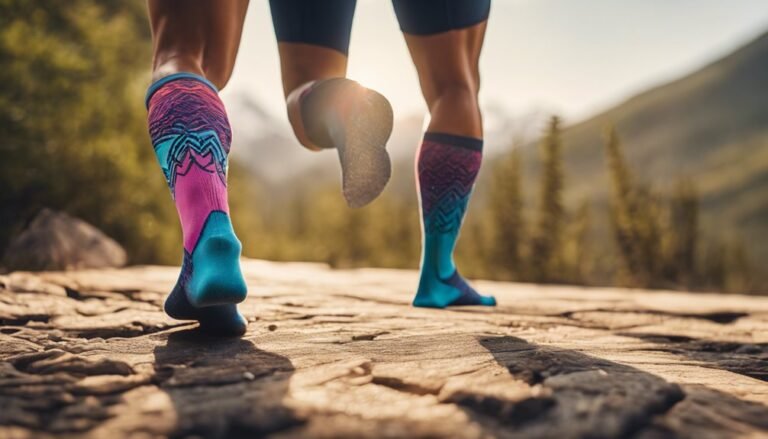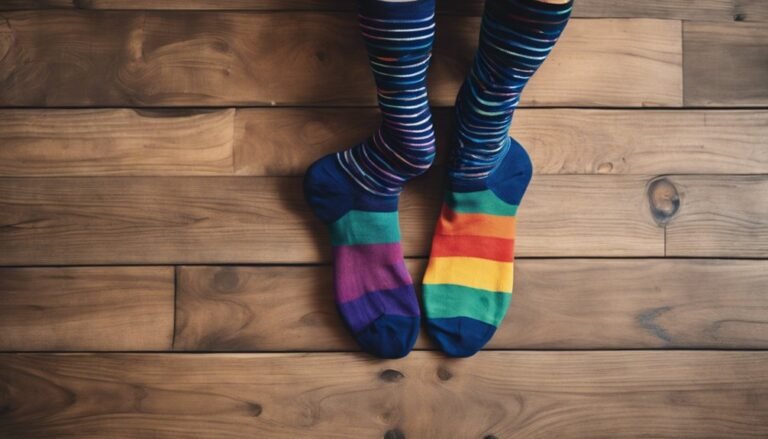Why Chefs Need Moisture-Wicking Socks
As a chef, you know long hours on your feet can lead to discomfort and fatigue. Moisture-wicking socks are designed to keep your feet dry, pulling sweat away from your skin and preventing odor. They reduce friction, lowering the risk of blisters and fungal infections, allowing you to focus on your cooking. Plus, their cushioned soles provide much-needed support during demanding shifts. Curious about how these socks can elevate your kitchen experience? There's more to discover!
Understanding Moisture-Wicking Technology

When you step into a bustling kitchen, the last thing you want is to be distracted by soggy socks, especially while juggling pots and pans. Moisture-wicking technology is your best friend here. This innovative fabric technology pulls moisture away from your skin, keeping your feet dry and comfortable. Instead of soaking up sweat like traditional materials, these socks actively transfer moisture to the outer layer, where it can evaporate quickly. This means you can focus on creating culinary masterpieces without worrying about slipping on a wet floor or feeling uncomfortable. With the right pair of moisture-wicking socks, you gain the freedom to move, cook, and thrive in the kitchen, ensuring that soggy socks are a thing of the past.
The Impact of Long Hours on Feet
After a long shift in the kitchen, it's easy to underestimate the toll those hours take on your feet. You're on your feet for what feels like an eternity, and that can lead to serious foot fatigue. The constant standing, rushing, and pivoting creates stress on your feet, leaving them sore and tired. Investing in ergonomic footwear can make a world of difference, providing the support needed to cushion your feet and alleviate pressure. Without proper footwear, you may find yourself battling discomfort that lingers long after your shift ends. By recognizing the impact of those long hours, you'll be more motivated to prioritize your foot health. After all, a chef's freedom to move efficiently in the kitchen is essential to their craft.
Benefits of Moisture-Wicking Socks for Chefs
While you're maneuvering through the fast-paced environment of a busy kitchen, moisture-wicking socks can be a game-changer for your comfort and performance. These socks excel at sweat management, drawing moisture away from your skin and keeping your feet dry throughout your shift. No one wants to deal with soggy socks while perfectly plating dishes! Plus, with built-in odor control, you can say goodbye to the unpleasant smells that accumulate during long hours on your feet. This means you can focus on creating culinary masterpieces without the distraction of discomfort. By choosing moisture-wicking socks, you're not just investing in your comfort; you're enhancing your overall kitchen experience, allowing you to move freely and confidently as you work your magic.
How Moisture-Wicking Socks Improve Comfort

As you navigate the bustling kitchen, comfortable feet are essential for maintaining focus and energy, and moisture-wicking socks play an important role in achieving that comfort. These specially designed socks use advanced sock materials that draw moisture away from your skin, keeping your feet dry and cool throughout your shift. When you're standing for long periods, this moisture control helps reduce foot fatigue, allowing you to stay on your feet longer without discomfort. The lightweight and breathable fabrics provide a snug fit, preventing excess movement that can lead to irritation. With moisture-wicking socks, you'll experience enhanced comfort, enabling you to concentrate on your culinary creations without distraction. Embrace the freedom to move with ease and confidence in the kitchen.
Preventing Blisters and Foot Injuries
If you spend long hours on your feet in the kitchen, preventing blisters and injuries is essential for your comfort and performance. Moisture-wicking socks can greatly reduce friction, while also providing enhanced foot stability to keep you moving effortlessly. Let's explore how these features work together to protect your feet throughout a busy shift.
Blister Reduction Techniques
When you're on your feet for hours in a bustling kitchen, preventing blisters becomes essential to maintain your comfort and performance. To keep your feet blister-free, start with effective blister prevention strategies. Choose moisture-wicking socks that fit snugly without being too tight; this is where sock fitting tips come into play. Make sure your socks don't bunch up, as that can lead to friction. Consider applying blister prevention tape on high-risk areas for added protection. Regularly inspect your shoes for wear and tear, as a proper fit can drastically reduce irritation. Finally, give your feet some breathing room during breaks. By implementing these techniques, you'll keep your feet happy and focused on what you do best—creating culinary magic!
Enhanced Foot Stability
Enhanced foot stability is vital for chefs maneuvering the fast-paced environment of a kitchen. With long hours on your feet, the right moisture-wicking socks can greatly improve your comfort and performance. They help maintain proper foot alignment and provide essential arch support, reducing the risk of blisters and injuries.
- Guarantees your feet stay dry and cool
- Reduces friction, preventing painful blisters
- Enhances overall foot stability for better balance
When you prioritize stability, you can focus on your culinary creations without distractions. By investing in quality moisture-wicking socks, you empower yourself to thrive in the kitchen, embracing every moment with confidence and freedom. Your feet deserve that level of care in a demanding work environment.
Temperature Regulation in a Hot Kitchen
Amid the hustle and bustle of a hot kitchen, maintaining a comfortable temperature can feel like an intimidating task. With sizzling pans and boiling pots, kitchen temperatures can skyrocket, leading to heat stress that affects both your performance and mood. You might find yourself sweating profusely, making it challenging to focus on your culinary creations. It's essential to stay cool and collected, as a comfortable chef is a productive chef. Implementing simple strategies, like adjusting ventilation or taking short breaks, can help combat the heat. Remember, your feet are the foundation of your movement, so ensuring they remain dry and comfortable is critical. When you manage your body temperature effectively, you can release your creativity without the burden of discomfort.
Choosing the Right Moisture-Wicking Socks
Finding the right moisture-wicking socks can make a significant difference in your comfort while working in a hot kitchen. Choosing wisely means considering both sock materials and sock fit. You want socks that breathe, move with you, and keep your feet dry. Here are a few tips to guide your selection:
- Look for synthetic fibers like polyester or nylon, which efficiently wick away moisture.
- Ensure the fit is snug but not too tight, preventing bunching that can cause blisters.
- Opt for cushioned soles for added comfort during long shifts on your feet.
Testimonials From Chefs Who Made the Switch

Imagine slipping on a pair of moisture-wicking socks after a long shift in the kitchen. Chefs who've made the switch rave about the enhanced comfort and how their feet feel healthier at the end of the day. It's not just about staying dry; it's about transforming your entire work experience.
Enhanced Comfort Levels
When chefs trade their traditional socks for moisture-wicking alternatives, they often discover a remarkable difference in comfort throughout their long shifts. Enhanced comfort translates directly into improved daily performance, helping you tackle each service without the burden of foot fatigue.
- The snug fit keeps your feet securely in place, reducing friction.
- Advanced moisture-wicking technology keeps your feet dry and cool, even during peak hours.
- Breathable materials provide ventilation, making every step feel lighter.
Chefs who've made the switch rave about the newfound freedom in their feet. No more distractions from discomfort means more focus on culinary creativity. With moisture-wicking socks, you'll experience a transformation that fuels your passion and elevates your work experience.
Improved Foot Health
Many chefs have discovered that switching to moisture-wicking socks not only enhances comfort but also markedly improves foot health. These innovative sock materials draw moisture away from your skin, keeping your feet dry and reducing the risk of blisters and fungal infections. Chefs like you have shared how this simple change elevated their foot hygiene, allowing them to focus on their culinary artistry without discomfort. By maintaining dryness, you'll prevent odors and infections, ensuring your feet feel fresh and revitalized after long shifts. One chef noted, "Since I made the switch, my feet don't ache like they used to." With moisture-wicking socks, you can enjoy the freedom to move confidently in your kitchen, knowing your foot health is well taken care of.
Frequently Asked Questions
Can Moisture-Wicking Socks Be Used for Other Professions?
Imagine a marathon runner, their feet dancing gracefully over the pavement. Just like that, moisture-wicking socks can benefit various professions, offering comfort and support through moisture wicking benefits and professional applications, enhancing your daily performance.
How Do I Wash and Care for Moisture-Wicking Socks?
To care for your moisture-wicking socks, use gentle washing techniques, avoiding fabric softeners. This'll enhance sock longevity and keep them performing well. Air-drying's best, letting them breathe and stay fresh for your active lifestyle.
Are Moisture-Wicking Socks Suitable for All Foot Sizes?
Moisture-wicking socks come in various sizing options, ensuring you can find the perfect fit for your foot comfort. They're designed to accommodate different shapes and sizes, so you can enjoy freedom and flexibility all day.
Do Moisture-Wicking Socks Come in Different Thicknesses?
Yes, moisture-wicking socks come in various thicknesses. They're crafted from different sock materials, offering insulating properties that suit your comfort needs. Select thicker options for warmth or thinner ones for breathability—freedom to choose what feels best!
Can I Wear Moisture-Wicking Socks in Winter?
You can definitely wear moisture-wicking socks in winter! Their unique materials offer winter benefits, keeping your feet dry and warm. You'll enjoy the freedom to move comfortably, regardless of the chilly temperatures outside.







